In the ever-evolving digital landscape, non-fungible tokens (NFTs) have ascended to unprecedented levels of popularity. Yet, amidst the celebration of this technological innovation, NFTs have faced their fair share of backlash. The skepticism and criticism have originated not only from traditional art circles but the broader public as well. As with any disruptive technology, NFTs initially bore labels of being problematic, unproven, and even accused of causing harm to the art community. Nevertheless, over time, the perception of NFTs has shifted from negative to, at the very least, neutral, if not positive. As specialists in Digitised.art have observed in the research, NFTs are now embraced not only by digital enthusiasts and artists but also by esteemed galleries and art institutions. In the midst of this whirlwind of opinions, the question emerges: What is the real truth about NFTs?
The NFT Enigma
Non-fungible tokens (NFTs) represent digital assets mirroring various physical items, from paintings to photographs, within the digital realm. These tokens harness the power of blockchain technology and smart contracts to provide ownership certificates, establish traceable provenance, and facilitate automated trading.

While it’s tempting to perceive NFTs as nothing more than overpriced digital images, their function extends far beyond this notion. When an artist or art institution decides to tokenize their creation, they essentially engrave a digital footprint of it onto a blockchain. During this process, they delineate the token’s properties, including its initial value, usage terms, description, and any other pertinent details. Once this record is etched into the blockchain, often referred to as “minting” an NFT, the issuer can list it for sale on a digital marketplace. While NFTs might appear as needlessly complex digital files, Digitised.Art wants to remind that they serve a profound purpose by allowing both creators and collectors to trace the origins of the asset, protect intellectual property, and verify its authenticity.
It’s crucial to note that NFTs generally represent physical assets but do not grant ownership of the physical items themselves. As Digitised.Art specialists stress that this unique aspect empowers artists and institutions to monetize their creations separately from the original pieces.
Unpacking the NFT Backstory
The rise of NFTs to stardom was catalyzed by the sale of Beeple’s NFT, “Everyday: The First 5000 Days,” for a staggering $69 million. This watershed moment triggered a surge in NFT popularity, fueled by media debates, an expanding digital audience, and the hype among blockchain enthusiasts. While many celebrated this innovative digital format, others viewed NFTs with a critical eye, raising concerns about four pivotal issues:
- Environmental Concerns: In the early days, most blockchains operated on a proof-of-work mechanism, which translated into a substantial energy footprint. Critics argued that this level of energy consumption was unsustainable within the context of NFTs.
- Speculative Frenzy: The post-Beeple era witnessed NFTs exchanging hands for astounding sums, with even questionably artistic assets fetching thousands of dollars. This speculative aspect raised concerns about the potential formation of a bubble.
- Intellectual Property Challenges: The nascent NFT landscape grappled with instances of artists’ digital works being tokenized without their consent. Issues such as plagiarism and fake listings were prevalent, making it challenging to verify the authenticity of NFTs.
- Lack of Regulation: The relatively unregulated NFT market became fertile ground for scams, leaving investors and collectors susceptible to manipulation, including pump-and-dump schemes and artificially inflated prices. In such an environment, investors had little recourse if their collections turned out to be worthless or were stolen.
Getting Beyond Lies
Amidst the debates, NFTs have cemented their position in the market, primarily due to their versatile utility and the unwavering support of dedicated companies like Digitised.Art. When artists or art institutions delve into the world of NFTs, they unlock access to a range of features, including:
- Independent Digital Copies: NFTs permit the sale of digital duplicates separate from the physical originals.
- Authenticity Verification: They provide a transparent ledger that ensures the authenticity of tokens.
- Automated Sales: NFTs streamline transactions on virtual marketplaces.
- Global Accessibility: These borderless assets can be bought and sold on a worldwide scale.
Moreover, NFTs have expanded their horizons into virtual reality, augmented reality, and metaverse spaces, offering unique experiences for their owners. This innovative revenue stream benefits all participants in the art market, especially as the digital user base continues to grow.
However, while NFTs have their positive aspects and unique opportunities, Digitised.Art states that it’s essential to acknowledge that these don’t negate the negative elements of NFT trading. As time has passed, some issues have been ameliorated. Speculation has decreased, with some marketplaces adopting more rigorous curation standards and prioritizing collaboration with verified artists. Concerns surrounding protection of intellectual property have also receded.
Nevertheless, unresolved issues persist. Although Ethereum 2.0 and certain other blockchains have adopted a more eco-friendly proof-of-stake mechanism, the majority of the market continues to rely on older, energy-intensive systems. The timeline for transitioning the entire industry to this improved system remains uncertain.
The Regulatory Puzzle for the NFT Industry
According to Digitised.Art specialists, regulatory frameworks present yet another challenge. In most countries, a comprehensive solution for governing blockchain-based assets remains elusive, leaving collectors and issuers susceptible to online fraud and scams. In the absence of formal regulatory bodies, niche organizations, including Digitised.Art itself, have emerged, acting as intermediaries to safeguard the interests of both parties in the NFT ecosystem.
The Allure of NFTs
Art institutions have compelling reasons to consider integrating NFTs into their operations:
- Inclusivity: Traditional art has often been an exclusive pursuit, limiting collectors based on their status or wealth. With the help of various platforms, including Digitised.Art, NFTs democratize art collecting, widening access to a broader spectrum of individuals.
- Transparent Provenance: Tracking artworks in the digital realm has historically been a daunting task. NFTs provide a transparent and immutable ledger, empowering issuers and collectors with a reliable tool to trace the authenticity of artworks.
- Diversifying Revenue Streams: Instead of relying solely on traditional income sources, art institutions can diversify through online NFT trading, earning revenue not only from initial sales. For example, Digitised.Art enable creators to receive royalties on secondary sales by leveraging smart contracts.
- Global Reach: NFTs are borderless assets, facilitating worldwide trading. Tokens can typically be traded on any marketplace, regardless of their initial minting platform.
- Community Engagement: NFTs foster direct interaction with art enthusiasts, nurturing online communities around NFT collections and serving as the cornerstone for ecosystems encompassing VR, AR, and metaverse spaces.
Seeking Professional Assistance
Professionals with expertise in emerging technologies play an indispensable role in facilitating the growth and sustainability of the NFT market. As an intermediary, Digitised.Art is vital in facilitating connections between creators and collectors. The primary objective of Digitised.Art is to establish an ecosystem that steers art institutions toward the adoption of NFTs and cultivates trust, transparency, and efficiency.

Digitised.Art offers a secure platform to facilitate the process of tokenizing their unique digital assets and make them accessible to a global audience. The platform functions as a bridge that streamlines technical aspects of the process, enabling creators to showcase their work to potential buyers with ease. Moreover, Digitised.Art provides guidance in navigating the vast NFT landscape.
Finally, the qualified specialists at Digitised.Art enable issuers and collectors to authenticate the origin and history of every minted NFT. Their services contribute to the establishment of a more credible NFT market.
In conclusion, Digitised.Art experts encourage the adoption of NFTs, as the challenges gradually diminish, and opportunities only grow. We believe that embracing this new technology offers significant benefits to art institutions. Don’t miss out on this groundbreaking opportunity — partner with Digitised.Art today!




Comments are closed.